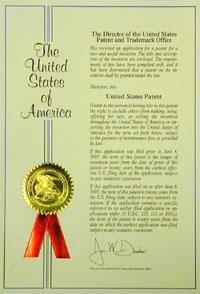Intellectual Property Information
Property is something that can be owned, and, consequently, bought and sold. Everyone is familiar with real estate, which is one type of property. Intellectual property is property that begins as an idea, that is, it is created in the mind. Intellectual Property is intangible property. Unlike real property such as land, intellectual property does not exist in a physical form. Intellectual property has value because of our legal system. Each country has its own laws relating to what constitutes intellectual property and the protection it can receive. In the United States, intellectual property includes patents, trademarks, copyrights, and trade secrets.
Some forms of intellectual property are represented by paper, for example, the US Patent and Trademark Office (PTO) sends the patent owner a Letters Patent when a patent issues. But, the Letters Patent is not a title to the patent or the original idea. The Letters Patent is just a certificate issued to the patent owner.
Table 1 below summarizes the major differences between a patent, a copyright, a trademark, and a trade secret with respect to protecting that intellectual property within the United States. For more information regarding patents, see the Patent FAQ. For other info, see the White Papers listed on the IP Links page. The white papers include information for Independent Inventors. The papers also include information on IP Considerations for Businesses and Patent Strategies, along with information on the America Invents Act of 2011.
There are types of intellectual property that do not fall with the four categories listed in the table. For example, there are specific laws relating to mask works and boat hull designs. Please feel free to contact a patent attorney at Knox Patents for a full explanation of this table and for other information regarding intellectual property protection.
|
